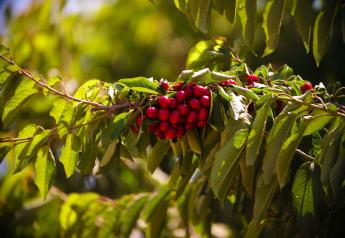Western growers seek new ways to safeguard crops, secure stable water supply

In recent weeks, the collective sigh of relief from growers in California has been palpable. While the West continues to experience unprecedented extreme weather events and patterns, above-normal rainfall in recent months provided cause to celebrate.
According to the U.S. Drought Monitor, the recent deluge has helped satiate the dryness and drought conditions across much of the Golden State. Added to this, drought monitor statistics have recently confirmed that the Sierra Nevada and mountain foothills in central California are now free of drought and abnormal dryness for the first time since January 2020.
“The rain has improved California soil moisture and streamflow levels, while the snow has increased mountain snowpack to much above-normal levels. Most California reservoirs have refilled with water levels near or above average, but groundwater levels remain low and may take months to recover,” according to the weekly U.S. Drought Monitor.
Even with the unexpected windfall, Western growers are staying vigilant, continuing to scrutinize water availability with more attention than previous seasons. Those who have been around a few seasons know better than to let their guard down.
Rolling with the punches
In early March 2023, the California Department of Water Resources announced sustainability plans for the state’s groundwater basin. The agency recommended approving plans for six California groundwater sub-basins and declared six other plans to be “inadequate.”
“Passage of the Sustainable Groundwater Management Act in the 2014 drought year was a seismic shift in California water,” California Farm Bureau President Jamie Johansson responded in a news release. “It was never going to be easy to transition on a timeline of just 20 years to eliminate an estimated 2.5 million acre-feet of overdraft a year in our most impacted areas of the state.”
Historic droughts in recent years have shown California farmers that they can’t simply continue the status quo; the state also must invest in a more resilient, 21st century water system, Joahansson continued.
Related news: California fruit growers relieved by projected increase to water allocation
“Our groundwater supplies are critical for California farmers, including vegetable, fruit, nut and dairy producers who account for much of America’s food supply,” Joahansson said in the release. “It is important that California carefully consider solutions that protect both our aquifers and our food production.”
North of California, growing food presents different challenges.
“One of the only constants in farming is that Mother Nature throws curveballs each year in the form of weather,” Stemilt Growers Marketing Director Brianna Shales told The Packer. “We had our coldest spring in a century last year and record heat the year before. Wildfires are something we contend [with] often in Washington state.”
Despite the unpredictable weather and wildfires, the Washington-based tree fruit grower is staying put. Even with weather challenges, the state remains an ideal place for Stemilt to grow fruit because of the arid climate and the available natural resources such as water, snowpack and clean energy from hydropower, Shales said.
“Weather is still going to present obstacles in the future, but water is still a great resource that we have in Washington state,” she said. “Modern orchards have become advanced at using water in prescribed ways, and we will continue to use technology to help us make the best decisions for the fruit and for the land.”
Monitoring water flow in the orchards and at facilities is crucial to conserving the precious resource, Shales said. Soil-moisture monitoring along with precision irrigation from drip irrigation and microirrigation systems target water in exact amounts to the specific trees that need it, she said.
Cultivating climate resiliency for Southwest growers
In the face of what the University of Arizona has called “the worst water crisis in state history,” researchers are offering new farming practices and water policies that they believe can help the Southwest agricultural industry thrive while also sustaining the threatened ecosystem and water reserves in the Lower Colorado River Basin.
The suggestions and approaches were recently presented in an action-focused report, “Toward Water-Resilient Agriculture in Arizona: Future Scenarios Addressing Water Scarcity in the Lower Colorado River Basin." The report is among the university’s initiatives intended to support Arizona farmers.
The university and three nonprofit organizations received a $4.7 million grant from the USDA in late 2022 to from the Arizona Partnership for Climate-Smart Food Crops, a three-year project that will help farmers throughout the state more rapidly implement climate-friendly solutions that reduce costs while promoting value-added products in the economy, according to a news release.
"This agricultural water crisis is arguably the worst in the Colorado River watershed since Arizona statehood, more than a century ago," Gary Nabhan, a research social scientist at the Southwest Center, said in a news release. Nabhan is also the Kellogg Foundation endowed chair in Southwestern Borderlands Food and Water Security.
"It is important for the university to find and implement solutions that not only help Arizona farmers, but also assist all others who may soon be impacted by scarce resources and higher prices," he added.
Nabhan said in the release that changes in water policy have forced farmers to look toward increased groundwater pumping to meet irrigation needs, even though aquifers are already being depleted and pumping is costly. Declining aquifers, combined with rising temperatures, increased salinization of soil, and water loss through evaporation and transpiration add more stress to the water scarcity dilemma for Arizona farmers — even if they don't rely on surface water.
"These changes are making it increasingly difficult to grow the same crops or use the same irrigation practices that farmers across the desert Southwest have relied on for more than 100 years," report co-author Erin Riordan said in the release.
To launch a discussion about potential adaptations in the face of the growing water crisis, University of Arizona researchers sent out a 100-question survey in August 2022 to Southwest farmers, ranchers, water policy experts, agroecologists and food systems analysts.
Solutions that address key issues brought by survey respondents and stakeholders were as wide-ranging as the issues themselves and included strategies such as:
- Developing a market for reallocating water among agricultural users.
- Growing more climate-appropriate crops and native plants.
- Developing shaded areas or using solar panels to provide shade for agriculture.
"We hope to demonstrate that there are already potential solutions at hand that will help farmers cut input costs while garnering better prices for their harvests," Nabhan said in the release.
The report also highlights sources of technical, legal and financial support available to help farmers adapt to an ever-changing climate as well as to shifts in water and energy availability in Arizona.
Nabhan said in the release that the agricultural industry needs to invest in a transition to water- and fuel-efficient practices that serve as economically viable adaptations to long-term water scarcity "and not just in Band-Aid remedies that don't move the needle."
"If we can stabilize or increase crop value per acre while cutting water and energy costs, everyone stands to gain over the long haul," he added.







